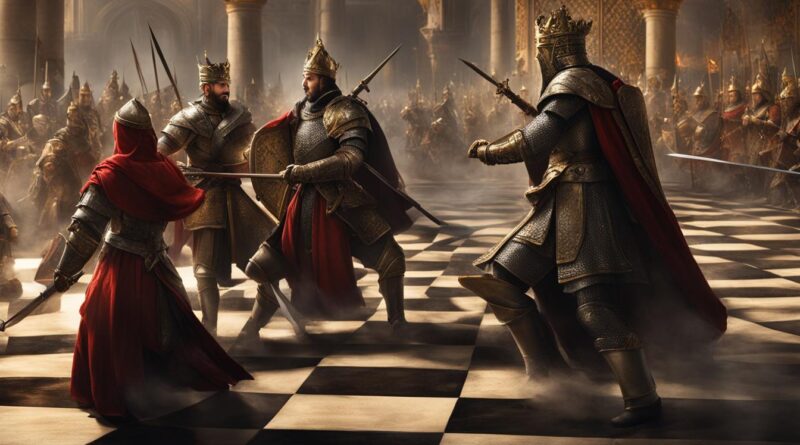Queen and Pawns vs. King and Knight in Chess
When it comes to the endgame of queen and pawns vs. king and knight in chess, understanding the strategies and tactics is crucial for success. This article will dive into the dynamics of this intense battle on the board, exploring the winning plans, draw positions, exceptions, and the role of key squares. Whether you’re a beginner or a seasoned chess player, this guide will provide valuable insights to improve your endgame skills.
Before we delve into the specifics, let’s take a look at the key takeaways from this article:
Key Takeaways:
- Understanding the winning plan in queen and pawns vs. king and knight endgame
- Identifying draw positions and utilizing stalemate ideas
- Exploring exceptions to the general rules and guidelines
- Recognizing the importance of key squares in king and pawn endgames
- Applying the rule of the square for successful pawn promotion
Winning Plan in Queen and Pawns vs. King and Knight Endgame
When facing an endgame of queen and pawns against king and knight in chess, the side with the queen holds a distinct advantage. With careful maneuvering, the player controlling the queen can implement a winning plan to secure victory. This winning plan involves forcing the opposing king to block its own pawn, enabling the queen to advance and dominate the board.
The first step in executing the winning plan is to restrict the movement of the opposing king. By strategically positioning the queen and pawns, the player can force the king to defend its own pawn and limit its options for escape. This creates an opportunity for the queen to advance and threaten checkmate.
Central pawns play a crucial role in the winning plan. If the opposing king is positioned far away, the central pawns can effectively control key squares and restrict the king’s movement. Additionally, the queen can use its superior mobility to create mating threats and force the king into unfavorable positions.
| Key Elements | Actions |
|---|---|
| Restrict the opposing king | Force the king to defend its own pawn and limit its mobility |
| Advance central pawns | Control key squares and restrict the opposing king’s movement |
| Utilize queen’s mobility | Create mating threats and force the opposing king into unfavorable positions |
Mastering the winning plan in the queen and pawns vs. king and knight endgame requires a deep understanding of piece coordination, calculation, and positional play. Players must carefully assess the position and find the most effective moves to achieve victory. By employing this winning plan, chess players can confidently navigate and triumph in this complex endgame scenario.
Draw Positions in Queen and Pawns vs. King and Knight Endgame
In the queen and pawns vs. king and knight endgame, there are certain positions that can result in a draw. These draw positions occur when the defending side can utilize specific strategies to prevent the winning plan of the side with the queen. One such scenario is when facing a bishop pawn or a rook pawn, and the opposing king is not close enough to support a successful promotion. In these cases, the defending side can employ stalemate ideas to force a draw.
Table: Examples of Draw Positions in Queen and Pawns vs. King and Knight Endgame
| Draw Position | Description |
|---|---|
| Bishop Pawn Draw | When facing a bishop pawn, the defending knight can utilize tactical maneuvre to neutralize the queen’s threats and force a draw. |
| Rook Pawn Draw | In the case of a rook pawn, the defending king can block the pawn’s progress and avoid being checkmated, resulting in a draw. |
These draw positions highlight the importance of careful positioning and strategic thinking in the queen and pawns vs. king and knight endgame. By recognizing the potential for a draw and understanding the specific techniques to achieve it, players can effectively defend against the side with the queen and secure a favorable outcome.
Exceptions in Queen and Pawns vs. King and Knight Endgame
While the general strategies in the queen and pawns vs. king and knight endgame tend to favor the side with the queen, there are exceptions to be aware of. These exceptions may arise from specific positions that deviate from the typical winning plans and draw positions.
One notable exception occurs when facing a rook pawn and the opposing king is far away. In this scenario, there are certain positions where white can still achieve victory. The key to success lies in maneuvering the queen and pawns effectively to overcome the challenges presented by the rook pawn and the distant king.
Another exception arises when the defender has a central pawn and the king is positioned in a way that it can withhold the queen’s advance. In such cases, the defending side can utilize tactical ideas, such as stalemate, to secure a draw. It is essential for players to study and understand these exceptions to have a comprehensive understanding of the queen and pawns vs. king and knight endgame.
Table: Exceptions in Queen and Pawns vs. King and Knight Endgame
| Scenario | Outcome |
|---|---|
| Facing a rook pawn with a distant king | White can still win |
| Defender has a central pawn with a blocking king | Draw can be achieved |
Importance of Key Squares in King and Pawn Endgames
In king and pawn endgames, understanding key squares is crucial for evaluating and strategizing. Key squares play a significant role in determining whether a pawn can successfully promote and force checkmate, which ultimately leads to victory. These squares act as critical checkpoints for both the attacking and defending players, influencing the outcome of the endgame.
When assessing key squares in king and pawn endgames, it is important to consider the position of both kings and the pawn. The defending king must aim to control the key squares, preventing the attacking king from infiltrating and supporting the pawn’s promotion. Conversely, the attacking king should maneuver to occupy the key squares, opening up pathways for the pawn’s advancement.
In order to illustrate the concept of key squares in king and pawn endgames, the following table provides an overview of common key squares based on the pawn’s starting position:
| Pawn Starting Position | Key Squares |
|---|---|
| Central Pawn (e2 or e7) | e4, d4, e5, d5 |
| Rook Pawn (a2 or a7) | a3, b3, a4, b4 |
| Rook Pawn (h2 or h7) | h3, g3, h4, g4 |
| Pawn on Other Files | Dependent on the file |
By strategically recognizing and utilizing these key squares, players can create winning positions by either allowing the pawn to successfully promote or forcing the opponent into unfavorable defensive positions. Mastery of key squares is an essential skill for any serious chess player seeking to excel in king and pawn endgames.
Rule of the Square in King and Pawn Endgames
The rule of the square is a fundamental concept in king and pawn endgames. It provides players with a guideline to determine whether a pawn can promote unassisted or if the opposing king can catch the pawn, resulting in a draw. By visualizing a square based on the position of the pawn, players can make strategic decisions to secure victory or defend against the opposing forces.
When applying the rule of the square, the key is to understand the relationship between the pawn’s position and the square it needs to reach for promotion. The square is formed by extending the pawn’s path two ranks in front and two files on either side. If the opposing king is within this square, it can potentially catch the pawn, leading to a drawn position. However, if the opposing king is outside the square, the pawn has a clear path to promotion.
Let’s illustrate the rule of the square with an example:
| Position | Rule of the Square | Result |
|---|---|---|
| If the pawn can reach the f7 square (highlighted in green), it promotes and wins the game. | White wins. |
In the example above, White’s pawn can reach the f7 square, which is outside the square controlled by Black’s king. Therefore, White can promote the pawn and achieve victory. Understanding and applying the rule of the square allows players to assess the potential outcomes of king and pawn endgames, making informed decisions to secure their position and achieve success.
Key Squares for Rook Pawns in King and Pawn Endgames
In king and pawn endgames, rook pawns, which are pawns located on the a-file or h-file, pose unique challenges. These pawns have a lower chance of promoting compared to other pawns due to their starting position on the edge of the board. To determine the possibility of promotion for rook pawns, understanding the concept of key squares is crucial.
Key squares are critical squares that the attacking king needs to control in order to promote the pawn and secure victory. For rook pawns, the key squares differ depending on the file and the side of the board the pawn is located. Let’s take a closer look at the key squares for rook pawns:
| File | Key Squares |
|---|---|
| a-file | b7, b8 |
| h-file | g7, g8 |
When a rook pawn is on the a-file, the key squares are b7 and b8, as these squares need to be controlled by the attacking king to support the pawn’s promotion. Similarly, when a rook pawn is on the h-file, the key squares are g7 and g8. These squares serve as critical checkpoints for the attacking king to ensure the pawn’s advancement.
It is important to note that the defending king’s ability to reach these key squares can prevent the rook pawn from queening. By strategically blocking the path to the key squares or maintaining control over them, the defending side can aim for a draw or even a win in certain scenarios. The interplay between the attacking and defending kings and their access to the key squares greatly influences the outcome of rook pawn endgames.
Understanding the significance of key squares for rook pawns in king and pawn endgames is essential for evaluating and playing out these complex endgame positions. Whether aiming for promotion or defending against it, controlling these key squares can make all the difference in determining the outcome of the game.
Key Squares for Pawns Other Than Rook Pawns in King and Pawn Endgames
Pawns other than rook pawns play a significant role in king and pawn endgames, offering better chances of promotion. Understanding the key squares for these pawns is crucial in navigating these endgame positions and securing victory. The key squares vary depending on the rank of the pawn, offering multiple possibilities for successful promotion.
When considering the key squares for pawns other than rook pawns, it’s important to assess their position on the board. For example, a pawn on the sixth rank has the potential to promote with the support of the king, while a pawn on the seventh rank can often advance to the eighth and transform into a queen. By strategically advancing these pawns and occupying key squares, players can outmaneuver the opposing king and secure a winning position.
Let’s take a look at a comprehensive table showcasing the key squares for pawns other than rook pawns:
| Pawn Rank | Key Squares |
|---|---|
| 6th |
|
| 7th |
|
By leveraging the key squares presented in the table, players can efficiently plan their pawn advances and position their king to support successful promotion. It is important to note that the key squares highlighted are general guidelines and may vary depending on the specific positions and configurations within each king and pawn endgame.
Summary:
Pawns other than rook pawns have a better chance of promoting in king and pawn endgames. By understanding the key squares for these pawns and strategically maneuvering them, players can outmaneuver the opposing king and secure a winning position. The table provided showcases the key squares for pawns on the sixth and seventh ranks, offering valuable insights for successful pawn promotion.
Knight Pawn Exception in Key Squares Rule
In the world of king and pawn endgames, the concept of key squares plays a crucial role in determining the outcome of the game. However, there is an exception to the key squares rule when it comes to the knight pawn. When the black king is backed into a corner and it is Black’s turn to move, certain key squares can lead to a stalemate position.
Let’s take a closer look at this exceptional scenario. When the black king is in the corner, and the white pawn is on the seventh rank, key squares such as f7 or f8 can result in a stalemate position. This means that the black king is not in check, but it has no legal moves available. The game ends in a draw, despite the presence of key squares that would typically indicate a winning position.
This exception requires careful play from both sides. The defending side must be mindful of the potential trapping possibilities and maneuver their pieces to avoid the stalemate situation. On the other hand, the side with the pawn must exercise caution and consider alternative strategies to secure victory when facing the knight pawn exception.
Summary
In most king and pawn endgames, key squares are vital in determining the success or failure of pawn promotion. However, the knight pawn presents an exception to this rule. When the black king is trapped in the corner and it is Black’s turn to move, certain key squares can lead to a stalemate position, resulting in a draw. Both players must navigate this exceptional scenario with caution and adapt their strategies accordingly.
Applying Key Squares in King and Pawn Endgames
Mastering the concept of key squares is essential when navigating the complexities of king and pawn endgames. By strategically applying this knowledge, players can create winning positions and secure victory. The key squares serve as crucial checkpoints that determine whether a pawn can successfully promote, leading to potential checkmate.
When considering king and pawn endgames, the main objective is to maneuver the king to occupy key squares that support the pawn’s advance. By placing the king on these strategic squares, players can protect the pawn from being captured and allow it to safely promote. This requires careful calculation and foresight to ensure the opposing king cannot hinder the pawn’s progress.
The application of key squares becomes particularly important in the endgame scenario where the king and pawn face off against the opposing king. By tactically positioning the king on the correct squares, players can create a barrier that prevents the opposing king from reaching the pawn. This control over key squares can ultimately lead to the successful promotion of the pawn, checkmate, and a victorious outcome.
FAQ
What is the winning plan in the queen and pawns vs. king and knight endgame?
The winning plan involves forcing the opposing king to block its own pawn, allowing the queen to advance and secure victory.
Are there any draw positions in the queen and pawns vs. king and knight endgame?
Yes, certain positions can result in a draw, especially when facing a bishop pawn or a rook pawn and the opposing king is not close enough. Stalemate ideas can be used to force a draw.
Are there any exceptions in the queen and pawns vs. king and knight endgame?
Yes, there are certain positions where white can still win even when facing a rook pawn and the king is far away. These exceptions may deviate from the typical winning plans and draw positions.
How important are key squares in king and pawn endgames?
Key squares play a significant role in determining whether a pawn can successfully promote and force checkmate. Understanding the concept of key squares is essential in evaluating and playing out these endgame positions.
What is the rule of the square in king and pawn endgames?
The rule of the square is a fundamental concept that helps determine if a pawn can queen unassisted. Visualizing a square based on the position of the pawn allows players to assess if the opposing king can catch the pawn, resulting in a draw, or if the pawn can promote and secure victory.
Do rook pawns have different key squares in king and pawn endgames?
Yes, rook pawns, located on the a-file or h-file, present unique challenges. They have a lower chance of promoting compared to other pawns. The key squares for rook pawns can help determine the possibility of promotion.
Do pawns other than rook pawns have different key squares in king and pawn endgames?
Yes, other pawns have a better chance of promoting. The key squares for these pawns are determined by their position on the board and the rank of the pawn. Multiple key squares can lead to successful promotion.
What is the knight pawn exception in the key squares rule?
When the black king is in the corner and it is Black’s turn to move, certain key squares, such as f7 or f8, can result in a stalemate position. This exception requires careful play to avoid trapping possibilities for the defending side.
How can key squares be effectively applied in king and pawn endgames?
By strategically maneuvering the king to occupy key squares, players can create winning positions and prevent the opposing king from hindering pawn promotion. Skillful utilization of key squares can lead to successful checkmate and victory.



